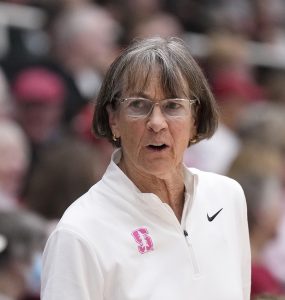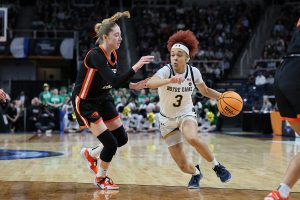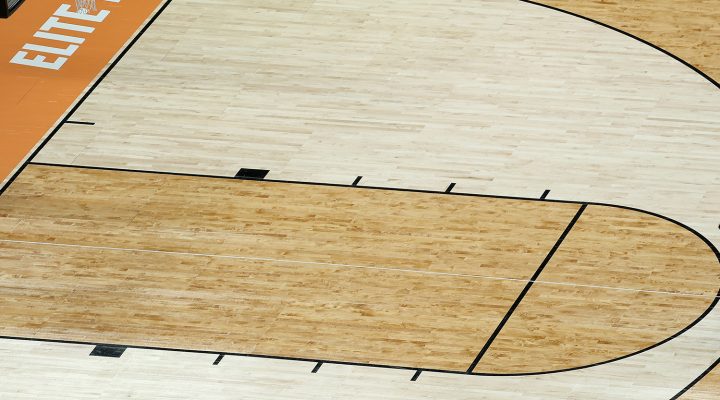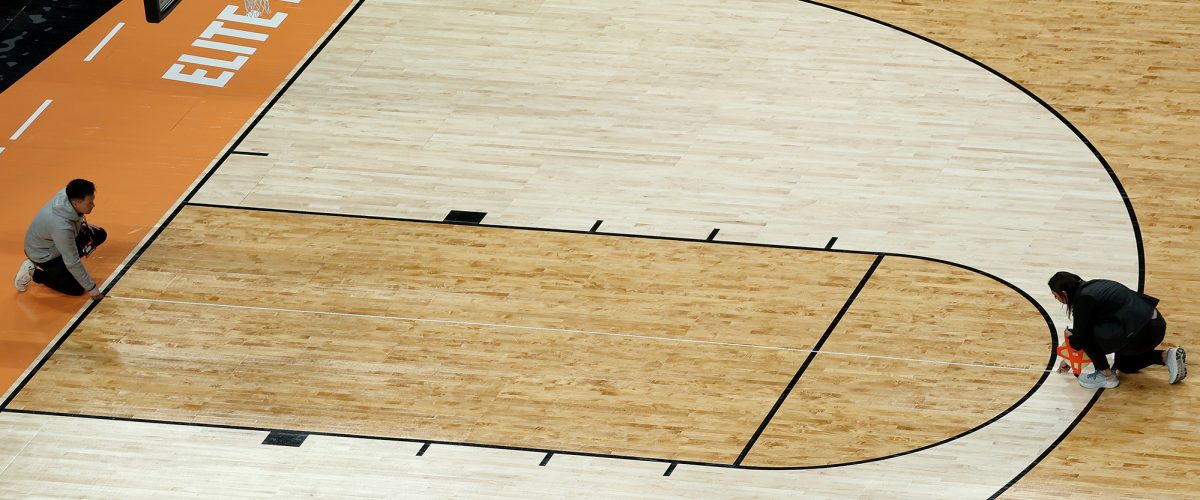Every March, millions of people locate their yellow highlighters and black pens as they compete against family, friends and coworkers for bragging rights in their March Madness bracket contest.
It all started in a Staten Island bar in 1977, where an 88-person bracket contest required $10 bets. And it’s grown beyond everyone’s wildest imagination since then.
According to one online betting source, “2024 could be the first year that 100 million brackets are submitted across the U.S.”
But despite the rise in popularity for college basketball during March Madness every year, this year’s tournament is a glaring example of the sexism many women in the United States face because they have to deal with foolishness men don’t have to.
Inaccurate three-point lines
After five games for the women’s tournament were played on a court in Portland, Ore., the NCAA admitted the three-point lines were off. One of the lines was a whole 9 inches shorter than the other one.
“I hate to say this, but I have a lot of colleagues who would say, ‘Only in women’s basketball,” said Texas head coach Vic Schaefer. “It’s a shame, really, that it even happened.”
The NCAA wrote in a statement regarding the courts that were built by Connor Sports: “The NCAA was notified today that the three-point lines on the court at Moda Center in Portland are not the same distance. The court will be corrected before tomorrow’s game in Portland. The NCAA regrets the error was not discovered sooner.”

Head coach Tara VanDerveer of the Stanford Cardinal looks on against the UCLA Bruins during the third quarter of an NCAA basketball game at Stanford Maples Pavilion on February 4, 2024, in Palo Alto, Calif. (Photo by Thearon W. Henderson/Getty Images)
Even though the discrepancy was experienced by both teams for each game since teams switch sides of the court at halftime, the timing and flow of each game was affected. In the five games that were played, teams shooting at the shallow three-point line made 26% of their three-pointers, while the teams shooting at the standard three-point line made 33% of their three-pointers.
During one Sweet 16 game, Stanford was in front of N.C. State by 10 points at halftime. But during the second half, when Stanford switched to the shallow end, they were just two for 13 shooting from behind the arc, while N.C. State shot 50% at the standard end and came from behind to win the game.
In an email after the game, Stanford Coach Tara VanDerveer wrote: “Who knows how much it could impact a team? You miss shots, people get frustrated, etc. Either way, it is shoddy workmanship and a lack of accountability. When you go to the gym you trust that the lines are correct and the basket is at the right height. Not a good look.”
Misogyny in the press
Another example of sexism in women’s college basketball came from Los Angeles Times columnist Ben Bolch. In a piece published March 29, Bolch framed the matchup between UCLA and LSU as a contest between “America’s sweethearts vs. its basketball villains.”
He referred to the LSU players as “dirty debutantes” and “villains,” while calling UCLA’s women “milk and cookies.”

Ben Bolch
“Take your phone out right now and Google ‘dirty debutantes’ and tell me what it says,” LSU Head Coach Kim Mulkey retorted. “‘Dirty debutantes’? Are you kidding me?”
According to Google, “Dirty Debutantes” is one of the longest-running series in porn.
The Times republished the story on April 1 with the note: “A previous version of this commentary did not meet Times editorial standards. It has been updated.”
Bolch also apologized. “Words matter,” he said. “As a journalist, no one should know this more than me. Yet I have failed miserably in my choice of words. … I tried to be clever in my phrasing about one team’s attitude, using alliteration while not understanding the deeply offensive connotation or associations. I also used metaphors that were not appropriate.”
He added, “Our society has had to deal with so many layers of misogyny, racism and negativity that I can now see why the words I used were wrong.”

Hannah Stuelke, #45 of the Iowa Hawkeyes, shoots the ball over Angel Reese, #10 of the LSU Tigers, during the second half in the Elite 8 round of the NCAA Women’s Basketball Tournament at MVP Arena on April 01, 2024. in Albany, N.Y. (Photo by Andy Lyons/Getty Images)
‘I’m still human’
After their 94-87 loss to Iowa during the Elite Eight on Monday night, LSU star Angel Reese had some things to say about how she’s been treated off the court this year.
“I’ve been through so much. I’ve seen so much,” she said. “I’ve been attacked so many times. Death threats, I’ve been sexualized, I’ve been threatened. I’ve been so many things, and I’ve stood strong every single time.”
Reese told the media she’s been dehumanized ever since winning last year’s championship against Iowa. But she reminded everyone, “I’m still human.”
Removing the nose ring with pliers

Hannah Hidalgo, #3 of the Notre Dame Fighting Irish, handles the ball against Dominika Paurova, #3 of the Oregon State Beavers, during the first half of their matchup in the Sweet 16 round of the NCAA Women’s Basketball Tournament at MVP Arena on March 29, 2024, in Albany, N.Y.. (Photo by Andy Lyons/Getty Images)
Notre Dame guard Hannah Hidalgo has played the entire season wearing a nose ring and started her Sweet 16 matchup against Oregon State wearing it like she always does.
According to Hidalgo, one of the officials told her the nose ring was a rule violation, but she could wear it if she covered it up. But then one of the other officials told her she had to remove it.
Hidalgo spent half the second quarter on the bench while Notre Dame staff struggled to use a pair of pliers in an attempt to remove her nose ring without causing her to bleed.
The All-American guard, who normally averages 22.6 points per game, missed her next 11 shots after returning to the game and didn’t score again until the fourth quarter as her team went on to lose by five.
The rise of women’s college basketball
Even though women in college basketball are having to face such foolishness, the sport has never been more popular.
The Elite Eight matchup between LSU and Iowa was the most-bet on women’s game ever in the United States, according to ESPN BET, DraftKings, FanDuel, BetMGM and Caesars.
According to Joe Pompliano, who is a sports entrepreneur and investor, the 12.3 million viewers for the Iowa vs. LSU game was more viewers than any women’s college basketball game ever, as well as more viewers than the 2023 NBA Finals, World Series, Orange Bowl, Big Ten Championship, Cotton Bowl, Pac-12 Championship, Big-12 Championship, ACC Championship, Peach Bowl, Thursday Night Football, and “every 2023 college football regular season game except Ohio State vs. Michigan.”
And the popularity of the sport goes beyond just that game. The top five most-watched men’s college basketball games of 2023-24 averaged 10.38 million viewers per game, while the top five most-watched women’s basketball games averaged 6.88 million viewers per game. In fact, college basketball games on FOX had more viewers for women’s games than for men’s games this season.
“College basketball games on FOX had more viewers for women’s games than for men’s games this season.”
Additionally, for the Final Four games this weekend, the average price of tickets on the resale market for the men’s semifinal games is $1,001, while the average price for the women’s semifinal games are more than twice that at $2,323. Also, the tickets to the women’s championship game are going for nearly twice as much as the men’s championship game.
Investing in women’s sports
People often claim women’s sports don’t merit the attention and financial investment men’s sports do because they are not generating as much money. But the reality is more nuanced.
Despite the top women’s games garnering 66% of the viewers that men’s games bring in, the television deals are grossly imbalanced.
The men’s basketball tournament is currently in an eight-year deal worth $8.8 billion. But the women’s tournament signed a new eight-year deal in January worth $920 million. To make the difference even more stark, the men’s deal is for men’s basketball by itself, while the women’s deal includes 40 total sports.
The difference in investment goes all the way down to the subpar facilities female athletes have to deal with. During COVID, the difference was so severe that female athletes were given a cheaper, less-accurate coronavirus test than male athletes were.
In 2021, the law firm Kaplan Hecker and Fink conducted an NCAA Gender Equity Review. According to a summary of the 118-page report in the Washington Post: “The law firm’s initial review found evidence of ‘systemic’ inequities in nearly every facet of the NCAA’s basketball operations. The NCAA’s reporting structure treated women’s basketball officials as ‘subordinate’ to those in the men’s game, the report said. And a culture inside the NCAA viewed women’s basketball as a perpetual money-loser — a ‘mistaken’ narrative, the report found, that ran contrary to the sport’s growth. The NCAA frequently prioritized its men’s basketball tournament at the expense of the women’s game, the report found.”
“If women’s basketball had even a quarter of the $8.8 billion investment that men’s basketball has, imagine how much more viewers per game they could attract.”
Additionally, the NCAA prohibited the women’s tournament from using the “March Madness” brand in their advertising up until the 2022 tournament.
If women’s basketball had even a quarter of the $8.8 billion investment that men’s basketball has, imagine how much more viewers per game they could attract.
Taking women seriously
Part of the reason those in power don’t take women’s sports seriously enough is that they don’t take women seriously. Most of these sponsoring corporations are run by men. So to some degree, their devaluing of women in college athletics matches their devaluing women in the workplace, as evidenced in their hiring and payment trends.
But another reason may be that they know most Americans don’t take women seriously enough. Because the general public doesn’t take women seriously enough, the corporate executives know they can get away with putting all their money into the men.
What does the church say?
The injustice against women in the March Madness tournament is beyond obvious to anyone willing to read a few articles. For those who care about women and justice, it’s an opportunity to speak up. So what about the church?
In light of corporations and the general public devaluing women, does the church provide an alternative vision that values women by affirming, equipping, investing in and cheering them on? Or does the church sacralize the inequities by using theology to justify hierarchies based on sex or by dismissing the inequities because they don’t resonate with Republican political talking points?
Complementarians often claim those who focus on these inequities are simply angry liberal feminist promoters of Critical Race Theory. Occasionally, they may admit some fault when confronted with an extreme example. But they’ll see it as an exception to the norm while quickly adding, “And it’s not just in the church. Other people do it too!”
But how much has the church been a factor in promoting the dismissal of women in society, given the prevalence of gender hierarchies and stereotypes in the church?
The harsh reality for complementarian evangelicals is that you can’t provide an alternative to society’s dismissal of women if you’re theology determines what women can or cannot do simply because they’re women.
While female college athletes are tossed around in the foolishness of inaccurate three-point lines, misogynistic press coverage, dehumanizing threats and sexualization, and nose ring pliers, what if the church offered an alternative vision? What if the church repented of its complicity and took women seriously enough to stop putting them in their place and start affirming, equipping, investing in and cheering them on?

Rick Pidcock
Rick Pidcock is a 2004 graduate of Bob Jones University, with a bachelor of arts degree in Bible. He’s a freelance writer based in South Carolina and a former Clemons Fellow with BNG. He completed a master of arts degree in worship from Northern Seminary. He is a stay-at-home father of five children and produces music under the artist name Provoke Wonder. Follow his blog at www.rickpidcock.com.
Related articles:
What we should learn from Deion Sanders and Nebraska women’s volleyball | Analysis by Rick Pidcock
What the SBC can learn from NCAA women’s basketball | Opinion by Susan Shaw
Baptists, football and women who changed the game | Opinion by Eileen Campbell-Reed


